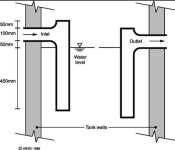dieselscout80
Veteran Member
We had to have our septic tank pumped due to the tank being full (symptom was toilet were gurgling when flushed).
We have heavy red clay that holds water and does not drain easily.
After that the system seemed fine for a few days maybe even a week then the toilet gurgling returned.
It seems that we have a easy flow type drain field (system install before we bought the house).
EZ Flow Septic Drainfield Systems | BARR Plastics Inc.
When we dug into it with a shovel some of the pellets have black on them and the guy stated that this means sewage got into the drain field and it is plugged.
He suggested that we add another 200' to the system setup so the old field is used first and then when it quits taking water gravity (dam made of a pvc tee that goes just above old field then down to the new field) the would cause it into flow to the new field.
The initial estimate is $2700 to $3000 to install the 80 feet of 3" hard pipe to get from tank to beyond the driveway and then the connections to the old field and the 200' of new field.
The new drain field would use infiltrator chambers I think like what is listed below.
Infiltrator Quick 4 Equalizer 36 Chambers - Q4EQ36 - Septic Solutions
Questions:
Is there away to restore the current systems capability to drain water?
Does their plan seem to be a good course of action?
Does the price seem fair?
Note we really need to have this fixed this week.
We have heavy red clay that holds water and does not drain easily.
After that the system seemed fine for a few days maybe even a week then the toilet gurgling returned.
It seems that we have a easy flow type drain field (system install before we bought the house).
EZ Flow Septic Drainfield Systems | BARR Plastics Inc.
When we dug into it with a shovel some of the pellets have black on them and the guy stated that this means sewage got into the drain field and it is plugged.
He suggested that we add another 200' to the system setup so the old field is used first and then when it quits taking water gravity (dam made of a pvc tee that goes just above old field then down to the new field) the would cause it into flow to the new field.
The initial estimate is $2700 to $3000 to install the 80 feet of 3" hard pipe to get from tank to beyond the driveway and then the connections to the old field and the 200' of new field.
The new drain field would use infiltrator chambers I think like what is listed below.
Infiltrator Quick 4 Equalizer 36 Chambers - Q4EQ36 - Septic Solutions
Questions:
Is there away to restore the current systems capability to drain water?
Does their plan seem to be a good course of action?
Does the price seem fair?
Note we really need to have this fixed this week.

